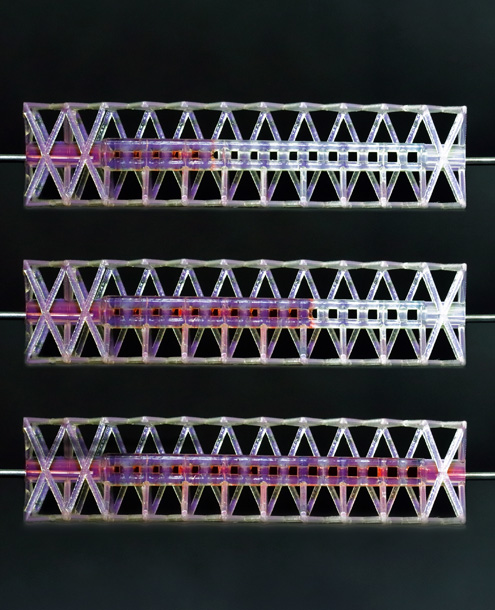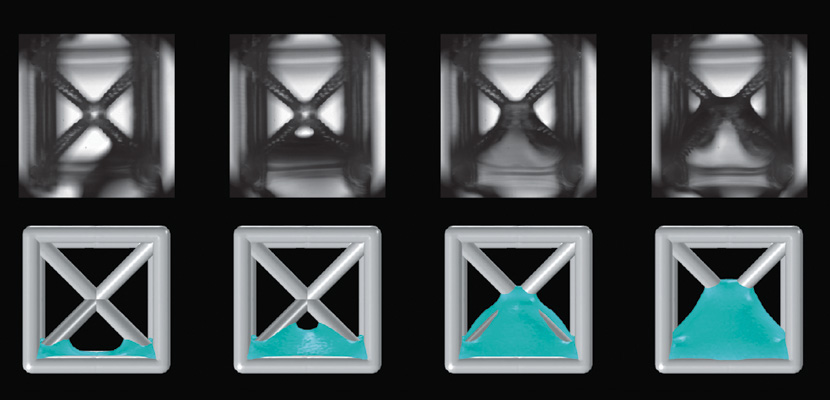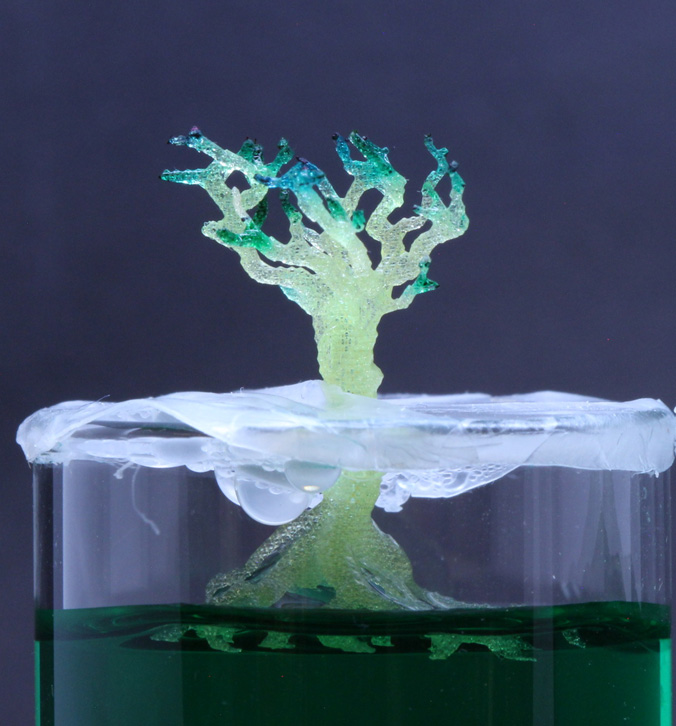Open Flow
By Fenella Saunders
These liquid-filled scaffolds are not enclosed, but they don’t leak.
These liquid-filled scaffolds are not enclosed, but they don’t leak.

A defining characteristic of a liquid is that it takes the shape of its container. It’s difficult to imagine a fluid flowing nicely along a pipe full of holes. But when things get small enough, that sort of arrangement is possible. Taking advantage of surface energy effects that tend to be stronger than gravity at small sizes, a team at Lawrence Livermore National Laboratory has come up with a 3D-printed unit with an internal structure that water clings to and flows into. Many of these units, or cells, can be printed together to create scaffolding-like structures that can pull liquids along like a tube—while they are completely open to the air. Networks of these scaffolds can move fluids on precise paths and provide maximum surface area for reactions.

Courtesy of Lawrence Livermore National Laboratory.
“We’re taking advantage of capillary phenomena that are the dominant factor when you shrink features below a critical size threshold,” said Eric Duoss, director of the Center for Engineered Materials and Manufacturing at the lab, “and that’s why we can get fluids to flow in a controlled fashion.”
The team tried out several cell structure designs before they found one that worked best. Each unit in the tiny scaffold is about a millimeter square, and it has an internal structure of cross-braced struts that create a sort of open pyramid shape. The team designs the scaffolds digitally, then prints them with a machine that uses a focused light to precisely harden a polymer layer by layer.

Courtesy of Lawrence Livermore National Laboratory.
The pyramid shape squeezes the space available to the liquid. “As the liquid is moving up that pyramid, if you can imagine it as a single pore, those crossed beams are effectively decreasing the pore size. The lower the pore size, the higher the capillary action,” explained Nikola Dudukovic, another researcher on the team. “We really saw the liquid speeding up and slowing down depending on where it was in the structure.” The liquid fills the pyramid (see above), sticking to the struts instead of flowing away, then moves on to the next cell.

Courtesy of Lawrence Livermore National Laboratory.
The research took some inspiration from transpiration in trees, so the team 3D-printed a treelike structure of their unit cells to show that their scaffolds could work in complex arrangements (see above). Using a reservoir of dyed water, their tree proved that the scaffolds could steadily transport fluid, a feature important for applications that use evaporative cooling. The structures could maybe even be used in outer space, where microgravity makes it difficult to move liquids around.

Courtesy of Lawrence Livermore National Laboratory.
An added feature of the structured cells is that by changing the thickness of the struts, the team was able to direct the flow of the fluids along specific paths (see above). “The cells with larger beams have a smaller pore size, so the fluid would prefer to go into those cells,” said Erika Fong, a researcher on the team. One application of this flow control would be to selectively deposit a metal. “That can create an anode and cathode for an electrochemical cell, which could be used like a battery for energy storage, or for electrochemical reactors,” said Duoss.

Courtesy of Lawrence Livermore National Laboratory.
The team was able to test a fluid-filled, cage-like scaffold (like the one above) as an absorber of carbon dioxide from the surrounding air (see videos from the research below and more at the end of the team's Nature paper). The structure creates a large liquid surface area for reactions. “We started an effort specifically for creating reactors that can convert carbon dioxide to value-added chemicals or fuels, such as ethylene or ethanol,” said Duoss. But the high surface area, combined with the COVID-19 pandemic, also has the team exploring the idea of sensing pollutants or viral aerosols with more precision. Said Fong: “We are hoping to find out if collecting biological aerosols in a liquid phase would make it easier to extract them and maintain their viability.”
Supplementary Video 1 from Cellular Fluidics, published in Nature.
A podcast with the researchers is below:
Click "American Scientist" to access home page
American Scientist Comments and Discussion
To discuss our articles or comment on them, please share them and tag American Scientist on social media platforms. Here are links to our profiles on Twitter, Facebook, and LinkedIn.
If we re-share your post, we will moderate comments/discussion following our comments policy.